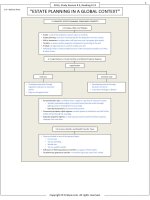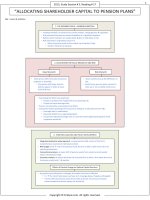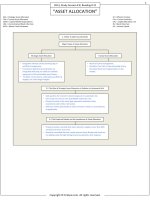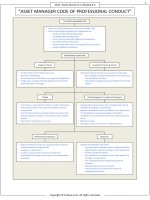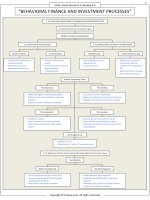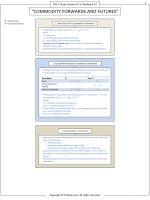FinQuiz smart summary, study session 14, reading 34
Bạn đang xem bản rút gọn của tài liệu. Xem và tải ngay bản đầy đủ của tài liệu tại đây (656.23 KB, 13 trang )
1
2013, Study Session # 14, Reading # 34
“RISK MANAGEMENT”
RG = Risk Governance
ERM = Enterprise Risk
Management
CG = Corporate Governance
DB = Defined Benefit
ESG = Environmental, Social
Governance
1. INTRODUCTION
Identification, measurement & control of risk are key to the investment process.
Risk management framework is applicable to the management of both
enterprise & portfolio risk.
Indentify which risks are worth taking on a regular or occasional basis & which
should be avoided altogether
VAR = Value at Risk
EAR = Earning at Risk
CR = Credit Risk
IR = Information Ratios
RAROC = Risk-Adjusted Return on
Capital
2. RISK MANAGEMENT AS A PROCESS
Risk management ⇒ a continuous process involving the identification of exposures to risk, establishing appropriate
ranges for exposures, measurement of these exposures & the execution of appropriate adjustments when required.
Risk management is a continuous processes (subject to evaluation & revisions) not just an activity.
Risk management process to a hypothetical business enterprise:
Nonfinancial Risk
The Company
Financial Risk
Set Policies &
Procedures
Information/Data
Define Risk
Tolerance
Information/Data
Derivatives
Identify Risks
Execute Risk Mgmt.
Transactions
Non-Derivatives
Measure Risks
Identify Appropriate
Transactions
Adjust Level
of Risk
Price Transactions
Execute Transactions
Measure Risks
Identify Source(s) of
Uncertainty
Select Appropriate
Model
Determine Market
Price or Value
Determine Model
Price or Value
Compare
Attractively Priced
Not Attractively Priced
Execute Transaction
Seek Alternative
Transaction
Copyright © FinQuiz.com. All rights reserved.
2
2013, Study Session # 14, Reading # 34
2. RISK MANAGEMENT AS A PROCESS
Risk management process to portfolio management:
Companies hedge risk that arise from areas in which they have
no expertise or comparative advantage &hedge tactically where
they have an edge (e.g. primary line of business).
Risk management involves risk modification.
3. RISK GOVERNANCE
RG ⇒process of setting overall policies & standards in risk
management is called RG
RG is of good quality if it is transparent, effective, efficient &
accountable.
Risk Governance Structure
Centralized
Decentralized
Single risk management group to
monitor & control the risk.
Also called ERM or firm wide risk
management.
Risk management by individual
business unit managers.
Benefit
Benefits
People closer to actual risk taking
are allowed to manage it
Economies of scale.
Allows a company to recognize
the offsetting nature of distinct
exposures.
Enterprise-level risk estimates
may be than individual units
(risk-mitigating benefits of
diversification).
Consider each risk factor to
which a firm is exposed (in
isolation & in terms of any
interplay).
Effective RG is possible only if the organization has effective CG.
Steps in effective ERM system:
Identify individual risk factors.
Quantify exposure in monetary term.
Use these inputs to a risk estimation model (e.g. VAR).
Indentify overall risk exposures & contribution from each risk factor
to overall risk.
Process of risk reporting to senior management.
Monitor compliance with policies & risk limits.
Effective ERM systems have centralized data warehouses which may
require a significant & continuing investment.
Copyright © FinQuiz.com. All rights reserved.
3
2013, Study Session # 14, Reading # 34
4. IDENTIFYING RISKS
Effective risk management requires the separation of risk exposures into
specific categories that reflect their distinguishing characteristics.
Financial risk ⇒ risk derived from events in the external financial markets.
Nonfinancial risk ⇒ all other forms of risk.
Taxes
Accounting
Legal
Regulations
Liquidity Risk
Nonfinancial Risks
The Company
Settlement
Financial Risks
Market Risk (interest rate, exchange rate,
equity prices & commodity prices risk)
Model
Operations
4.1 Market Risk
Market risk ⇒ risk associated with IR, exchange rates, stock prices & commodity prices.
Market risk is linked to supply & demand in various marketplaces.
DB plan measures market exposure in asset/liability management context.
4.2 Credit Risk
Credit risk ⇒ risk of loss caused by counterparty’s failure to make a promised payment.
Development of credit derivatives has blurred the lines b/w credit risk & market risk.
Before OTC credit derivative recognition, bond portfolio managers & bank officers were
the primary credit risk managers.
4.3 Liquidity Risk
Liquidity risk ⇒ risk of concession in financial instruments price because of the market’s
potential inability to efficiently accommodate the desired trading size.
In case of short squeezing, liquidity may completely dry up in the market.
For illiquid underlying, derivatives market may also be illiquid.
Size of the bid-ask spread is an imprecise measure of liquidity risk (because it is suitable
only for small trade size).
Complex liquidity measures are available to address the issue of trading volume.
Liquidity risk is difficult to observe & quantify.
Copyright © FinQuiz.com. All rights reserved.
Credit Risk
2013, Study Session # 14, Reading # 34
4.4 Operational Risk
Operational risk ⇒ risk of loss in a company’s internal (systems & procedures) or from
external events.
The risk can arise from:
Human errors (unintentional errors or willful misconduct).
Computer breakdown (hardware, software problems).
Act of God (only cash compensation for losses can be covered through insurance).
Rogue trader ⇒ trader that assumes irresponsibly level of risk or engaged in
unauthorized transactions or some combination of both.
Companies manage operational risk by monitoring their systems, taking preventive
actions & having a plan in place to respond if such events occur.
4.5 Model Risk
Model risk ⇒ risk that model is incorrect or misapplied (often valuation models).
Inappropriate model ⇒ chances of loss & control over risk is impaired.
Investors must scrutinize & validate all models they use.
4.6 Settlement (Herstatt) Risk
Settlement risk ⇒ risk that one party could be in process of paying the counterparty
while the counterparty is announcing bankruptcy.
Transactions b/w exchange members & clearing house removes settlement risk
Netting arrangement reduces settlement risk.
Transactions with foreign exchange component:
Don’t lend themselves to netting.
Parties are unaware to each other.
The risk is called Herstatt risk (bank Herstatt default).
Risk can be mitigated through continuously linked settlement (simultaneous
payments).
4.7 Regulatory Risk
Risk associated with the uncertainty of how a transaction will be regulated or potential
for regulation change.
Regulation is a source of uncertainty (risk that existing regulatory regime will ∆ or
unregulated market will become regulated).
Regulatory risk is difficult to estimate due to ∆ in political parties & regulatory
personnel.
Equivalent combinations of cash & derivative securities are not regulated by same way
or by same regulator.
4.8 Legal/Contract Risk
Legal/contract risk ⇒ possibility of loss arising from failure of legal system to enforce a
contract in which an enterprise has a financial stake.
Dealers should be very careful when writing contracts with their counterparties (due to
their advisory nature).
Contract law is often federally or nationally governed.
4.9 Tax Risk
Uncertainty associated with tax laws.
Tax policy often fails to keep pace with innovations in financial instruments.
Equivalent combination of financial instruments may be subject to different tax
treatments.
Copyright © FinQuiz.com. All rights reserved.
4
5
2013, Study Session # 14, Reading # 34
4.10 Accounting Risk
Uncertainty about transaction recording & potential for accounting rules & regulations
to ∆.
Historically accounting standards varied from country to country (more disclosure
requirements in some countries than others).
Accounting risk can be reduced by hiring personnel with latest accounting knowledge
(accounting risk will always remain).
4.11 Sovereign and Political Risks
Sovereign risk;
Form of credit risk involving sovereign nation’s borrowing.
Current credit risk & potential credit risk.
Its magnitude involves likelihood of default & the estimated recovery rate.
Willingness & ability to repay.
Political risk ⇒ risk of ∆ in the political environment.
4.12 Other Risks
ESG Risk
Performance Netting Risk
Environmental risk ⇒ leads to variety of –ve financial & other
consequences.
Social risk ⇒ risk regarding policies & practices of human
resources, contractual arrangements & work-place.
Governance risk ⇒ flaws in CG policies & procedures.
Performance netting risk;
Applies to firms that fund more than one strategy.
Firm will receive fee only if net +ve performance.
Firm will pay its portfolio managers on basis of individual
performance.
Asymmetric incentive fee arrangements with portfolio
managers.
Firms may have to pay to its portfolio managers when
firm’s revenue is zero.
Settlement Netting Risk
Risk of netting arrangement on profitable transactions for the
benefit of creditors challenged by liquidator of counterparty in
default.
Risk is mitigated by netting agreements that can survive legal
challenge.
5. MEASURING RISK
5.1 Measuring Market Risk
Exposure of actively traded financial instruments prices to ∆ in IR, exchange rates, equity
prices & commodity prices.
Volatility (S.D) is a statistical tool to describe market risk.
Adequate description of portfolio risk.
Suitable for instruments with linear payoffs.
Portfolio’s exposure to losses due to market risk:
Primary or 1st order measures of risk ⇒ adverse movement in a key variable (linear).
2nd order measures ⇒ ∆ in sensitivities (curvature).
Examples of primary risk measures are β (for stocks), duration (for bonds) & delta, vega &
theta (for options).
Examples of 2nd order measures are convexity & Gamma.
Copyright © FinQuiz.com. All rights reserved.
6
2013, Study Session # 14, Reading # 34
5.2 Value at Risk
VAR:
Probability-based measure of loss potential for a company, fund, portfolio, strategy
or transactions.
Expressed either in % or in units of currency.
Easily & widely used to measure loss from market risk but can also be used to
measure credit & other exposures (subject to greater complexity).
Can be described as a minimum or maximum VAR.
VAR implication:
It measures a minimum loss.
The probability, the VAR in magnitude.
VAR has a time element ( the period, the VAR).
5.2.1 Elements of Measuring Value at Risk
Establishing an appropriate VAR measure requires
a no. of decisions about the calculation structure.
Three Important Decisions in VAR
Picking a Probability Level
Choosing the Time Period
Selecting a Specific Approach
The probability, more conservative the
VAR estimate is.
Linear risk characteristics portfolios, two
probability level (e.g. 5% & 1%) will
provide identical information.
Optionality or nonlinear risks, select the
more conservative probability threshold.
VAR magnitude is directly related to time
interval selected.
Relationship is nonlinear.
Three standardized methods for estimating
VARs (discussed below).
5.2.2 The Analytical or Variance-Covariance Method
Assumptions ⇒ portfolio returns are normally distributed.
Standard normal distribution ⇒ expected value of zero & a SD of 1.
Conversion of a nonstandard normal distribution to a standard normal distribution:
ܱ ݐݏ݁ݎ݁ݐ݊ܫ݂݁݉ܿݐݑ− ݊ݎݑݐܴ݁݊ܽ݁ܯ
ܵܦ
ܸ = ܴܣሾܴ^ − ሺܼሻሺߪ ሻሿܸ
Estimation of expected returns & SD of returns is key to using analytical method.
If we are comfortable with normal distribution assumption & accuracy of our estimates, we can confidently use the
analytical method for a different time period by adjusting the avg returns & SD accordingly (e.g. annual VAR can be
converted to daily VAR by dividing avg return & SD to 250 (trading days)).
VAR (usually daily VAR) can also be estimated by assuming an expected return of zero. Two advantages:
No need to estimate E(R) which is harder to estimate than volatility.
Easier to adjust VAR for a different time period(݁. ݃. ܽ݊݊√ܴܣܸݕ݈݅ܽܦ = ܴܣܸ݈ܽݑ250).
Advantage/Disadvantage of Analytical Method
Advantage
Simple method
Disadvantage
Normal distribution assumption often
does not hold (e.g.in options).
Copyright © FinQuiz.com. All rights reserved.
7
2013, Study Session # 14, Reading # 34
5.2.3 The Historical Method
Collect the historical return & indentify the return below which 5% or 1% of returns fall.
No constraint to use normal distribution.
If different portfolio composition than what actually had in the past to calculate historical
VAR, it is more appropriate to call the method a historical simulation.
Advantage ⇒ non parametric.
Disadvantage ⇒ relies completely on past data (also a problem with other methods but
not so acute).
5.2.4 The Monte Carlo Simulation Method
MCS produce random portfolio returns which are assembled into a summary distribution
from which we can determine at which level the lower 5% (or 1%) of return outcomes
occur.
MCS does not require a normal distribution.
MCS is more flexible approach & even suitable for portfolios containing options.
As sample size sample VAR converge to population VAR.
MCS require extensive commitments of computer resources.
5.2.5 Surplus at Risk": VAR as It Applies to Pension Fund Portfolios
Pension fund managers apply VAR methodologies to the
surplus (rather their asset portfolio).
Managers express their liability portfolio as a set of short
securities & calculate VAR on net position (any VAR
methodology can apply).
5.3 The Advantages and Limitations of VAR
VAR’s Imperfections
VAR’s Attractions
Can be difficult to estimate.
Different estimation methods can provide different
results.
If assumptions are not accurate, VAR often
underestimate magnitude or frequency of worst returns.
Portfolio VAR is not simply the sum of individual
position’s VAR.
VAR provide incomplete picture of overall exposure
(ignore +ve results).
Back testing should be applied to check method’s
accuracy.
VAR estimate is not suitable for organization with
complex structure.
Quantify loss in simple terms.
Easily understood by senior management.
May be a requirement of regulatory body.
VAR is a verstyle measure.
VAR is often paired with stress testing.
VAR results are input dependent.
Copyright © FinQuiz.com. All rights reserved.
8
2013, Study Session # 14, Reading # 34
5.4 Extensions and Supplements to VAR
Incremental VAR ⇒ effect on portfolio VAR by including & excluding
an asset.
Provide extremely limited picture of the asset’s or portfolio’s
contribution to risk.
Cash flow at risk & EAR ⇒ with a given probability & over a specified
time period, the minimum CF (earnings) that we expect to be
exceeded.
Useful for companies that generate CF or earnings but not
readily valued in a publicly traded market.
Tail VAR ⇒ VAR plus the expected loss in excess of VAR, when such
additional loss occurs.
5.5 Stress Testing
Stress testing is used to supplement VAR as a risk measure.
VAR assumes potential losses under normal market conditions while
stress testing identifies additional losses due to unusual circumstances.
Approaches in Stress Testing
5.5.1 Scenario Analysis
5.5.2 Stressing Models
Evaluating a portfolio under different scenarios.
Effect of large movements in a key variable on portfolio’s value.
Stylized scenarios ⇒ simulating a movement in at least one primary market
force (e.g. IR, exchange rate etc.).
Problem ⇒it assumes that shocks tend to be applied to variables in a
sequential fashion (in reality shocks often happen simultaneously).
Actual extreme events ⇒ put the portfolio through price movements
resulting from the events that occurred in the past.
Hypothetical events ⇒ that have never happened in the markets (difficult
to analyze & confusing outcomes).
When a series of appropriate scenarios is established, the next step is to
apply them to the portfolio (consider assets’ sensitivities to the underlying
risk factors).
Use an existing model & apply shocks to the model inputs in some
mechanical way.
Range of possibilities rather than a single set of scenarios.
Computationally demanding.
Factor push ⇒ push risk factors & prices of a model in most disadvantageous
way & to work out the combined effect on the portfolio value.
Model risk is present.
Max. Loss optimizations ⇒ mathematically optimizing the risk variable that
will produce the maximum loss.
Worst-case scenario analysis ⇒ examines the expected worst case.
5.6 Measuring Credit Risk
Credit risk ⇒ risk that the party owing money to another will renege on the obligation.
CR has two dimensions:
Probability of loss.
Amount of loss.
Empirical data set on credit losses is quite limited with respect to time perspective, credit losses can be current or potential credit losses.
Cross-default provision ⇒ borrower’s default on any outstanding credit obligation is considered default on all outstanding credit obligations.
Credit or default VAR ⇒ reflects the probability of minimum loss during certain time period.
Credit VAR can’t be separated from market VAR & focus on upper tail of the distribution of market returns.
More accurate measures of default probability & recovery rate ⇒ & more accurate credit VAR.
Estimating credit VAR is complicated because:
Credit events are rare & harder to estimate.
CR is less easily aggregated than market risk.
Correlations b/w CR of counterparties must be considered.
Copyright © FinQuiz.com. All rights reserved.
2013, Study Session # 14, Reading # 34
5.6.1 Option-Pricing Theory and Credit Risk
A bond with CR can be viewed as:
Default free bond plus.
Short put option written by bondholders for shareholders (this put option reflects
shareholders right of limited liability).
Traditional put-call parity with
a little
bit changes
can beand
used
to draw
5.6.1
option-Pricing
Theory
Credit
Risk value of implicit put option.
Value of put option is the difference b/w default-free bond & bond subject to default.
5.6.2 The Credit Risk of Forward Contracts
Each party assumes the other’s CR.
No current CR exists prior to expiration (no payments are due).
If the counterparty with –ve value declares bankruptcy before the contract expiration, the claim of
non-defaulting counterparty is market value of forward contract at the time of bankruptcy.
5.6.3 The Credit Risk of Swaps
CR is present at a series of points during the contract’s life.
MV of contract can be calculated at any time to reflect potential CR.
CR of IR & equity swaps is largest during middle of swap’s life.
In case of currency swaps, the CR is greatest b/w midpoint to end of swap’s life.
5.6.4 The Credit Risk of options
Options have unilateral CR (after paying premium credit risk accrues entirely to
the buyer).
European options ⇒ no current CR until expiration ⇒ significant potential CR.
American option ⇒ current CR if holders decide to exercise option early.
Credit risk on derivative transaction tends to be quite small relative to that on
loan.
5.7 Liquidity Risk
Cost of an illiquid instrument can be measured through bid-risk spread.
Instruments that trade very infrequently at any price give illusion of volatility).
Practitioners often liquidity-adjust the VAR estimates.
5.8 Measuring Non-Financial Risks
These risks are very difficult to measure ⇒ usually lack of observable distribution
of losses related to these factors.
Techniques like extreme value theory is used if possible to model sources of risk
but these techniques are input dependent.
5.8.1 Operational Risk
Well publicized losses at financial institutions (e.g. rogue employees
theft) have put operational risk justifiable into the forefront.
Banks can measure their operational risk through Basel II.
Copyright © FinQuiz.com. All rights reserved.
9
2013, Study Session # 14, Reading # 34
6. MANAGING RISK
Key components:
Effective risk governance model.
Systems & technology to provide timely & accurate risk information decision makers.
Trained personnel to evaluate risk information.
Risk management is just a good common business sense.
6.1 Managing Market Risk
ERM system identifies appropriate risk tolerance levels.
Taking too little risk is as much problematic as taking
too much risk (e.g. possible rewards).
6.1.1 Risk Budgeting
Risk budgeting ⇒ efficient allocation of capital risk across various
units of an organization or portfolio managers.
Risk Budgeting
Organization Perspective
Portfolio Management Context
Allocation of an acceptable level of risk to
various departments of an organization.
In addition to VAR, risk can also be allocated
based on individual transaction size, amount
of working capital needed etc.
If correlation among departments is < 1, the
sum of risk budgets for individual units >
than organizational risk budget.
Assets class correlation adjusted IR can
determine the optimal tracking risk
allocation.
Investment manager’s allocation is positively
related to his correlation adjusted IR.
Risk budget allocation should be measured in
relation to risk to surplus (assets – liabilities).
6.2 Managing Credit Risk
Estimating default probability is difficult.
Credit risk is not symmetric & normally distributed (downside
only) thus not easily measured & controlled using SD & VAR.
6.2.1 Reducing Credit Risk by Limiting Exposure
Not lend too much money to one entity.
Not engage in too many derivative transactions with one
counterparty.
6.2.2 Reducing Credit Risk by Marking to Market
Credit risk can be reduced through marking to market an OTC
derivative contract.
OTC options are not marked to market (one sided +ve value).
Credit risk of option is normally handled by collateral.
Copyright © FinQuiz.com. All rights reserved.
10
11
2013, Study Session # 14, Reading # 34
6.2.3 Reducing Credit Risk with Collateral
Collateral posting is widely accepted as credit
exposure mitigant.
Collateral requirements are based on market
values & participants credit ratings.
6.2.4 Reducing Credit Risk with Netting
Payment netting credit risk by the amount of money that must be
paid.
Netting in the event surrounding a bankruptcy referred to as closeout
netting.
Cherry picking ⇒ bankrupt company attempting to enforce contracts that
are favorable to it while walking away from those that are unprofitable.
6.2.5 Reducing Credit Risk with Minimum Credit Standards and Enhanced Derivative Product Companies
Companies will not do business with organization of low credit quality.
EDPCs are SPVs which are used by banks to control their exposure to
rating downgrades.
6.2.6 Transferring Credit Risk with Credit Derivatives
Credit default swap ⇒ protection buyer pays the protection seller in
return for the right to receive a payment from the seller in case of specific
credit event.
Total return swap ⇒ protection buyer pays the total return in return for
floating rate payments.
Protection seller exposed to credit & IR risk.
Credit spread option ⇒ yield spread of a reference obligation & over a
referenced benchmark.
Credit spread forward ⇒ forward contract on yield spread.
Credit derivatives are used to eliminate as well as to assume credit risk.
6.3 Performance Evaluation
Risk adjusted performance is a critically important capital allocation tool
(homogenous units of exposure assumption) as measured against sensible
benchmarks.
Methodologies for Risk-Adjusted Performance
Sharpe Ratio
This ratio measures excess mean return over
Rf per unit of total risk.
SD assumes normal distribution so not
suitable for portfolios containing options.
RAROC
ா௫௧ௗ௧௨௩௦௧௧
௧௧௦
Capital at risk can be calculated in a variety of
ways & can take a no. of different forms.
Copyright © FinQuiz.com. All rights reserved.
12
2013, Study Session # 14, Reading # 34
Methodologies for Risk-Adjusted Performance
Return over Maximum Drawdown
Sortino Ratio
Max drawdown ⇒ largest difference b/w a
high watermark & subsequent low.
Portfolio managers should not be penalized
for +ve volatility (as in Sharpe ratio).
Downside deviation ⇒ rate of return
volatility below the minimum acceptable
return (MAR).
ܴܱ= ܦܣܯ
௩௧௨
%ௗ௪ௗ௪
the ratio, the better it is.
ܵ= ݅ݐܽݎ݊݅ݐݎ
(ெ௧௧௨ିெோ)
௪௦ௗௗ௩௧
If MAR is Rf then the only difference b/w
Sharpe ratio & Sortino ratio is due to
denominator.
If non-normal distribution = Sharpe ratio &
Sortino ratio behave much in similar way.
Sharpe ratio is preferred in finance theory.
6.4 Capital Allocation
In addition to capital preservation, risk management has
become a vital component for risk taking enterprises.
Risk management is a vital input into a capital allocation process.
Most effective approach to capital allocation ⇒ appropriate
combination of these methodologies:
Methodologies for Capital Allocation
1. Nominal, Notional, or Monetary Position Limits
2. VAR-Based Position Limits
Capital that a portfolio or business unit can use in specified activity.
Advantages:
Easy to understand & calculate.
Nominal position can be taken by using other assets (e.g.
derivatives).
Disadvantages:
Ignore effects of correlation & offsetting risks.
Not suitable in risk-control perspective.
In notional limits a VAR limit serves as a proxy for capital allocation.
Advantage ⇒ appropriate for risk control process.
Problem ⇒ dependent on VAR’s effectiveness.
3. Maximum Loss Limits
Determine a maximum loss limit.
Max loss limit should be determined carefully (preserve capital & not
constrained in meeting investment objectives).
4. Internal Capital Requirements
Capital, the management believes to be appropriate for the firm.
If regulatory capital requirement is , overrule internal requirements.
Traditionally, capital ratio was used to specify internal capital
requirements.
Modern approach ⇒ firm will be insolvent if in asset is than value
of capital.
VAR based capital requirement has an advantage over regulatory
capital requirement ⇒ it consider correlations.
5. Regulatory Capital Requirements
May be inconsistent with rational capital
allocation scheme.
Part of overall allocation process whenever
demanded by overall allocation process.
Copyright © FinQuiz.com. All rights reserved.
2013, Study Session # 14, Reading # 34
6.5 Psychological and Behavioral Considerations
Behavioral aspects have two implication of risk management:
At different points in portfolio management cycle, risk
takers may behave differently.
Risk management can be better implemented if these
dynamics could be modeled.
Copyright © FinQuiz.com. All rights reserved.
13



